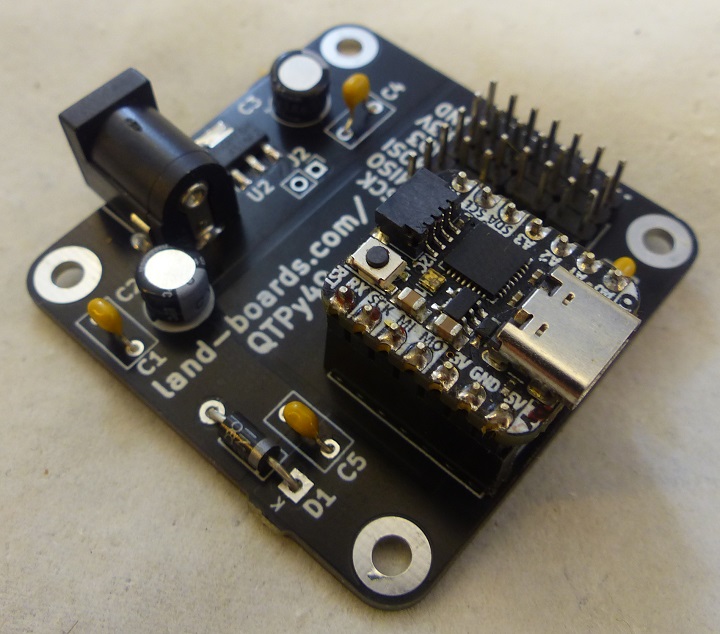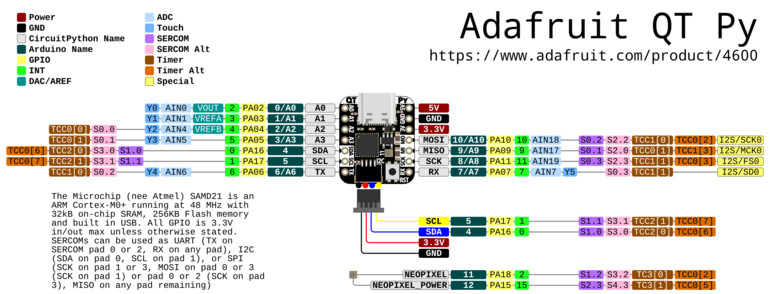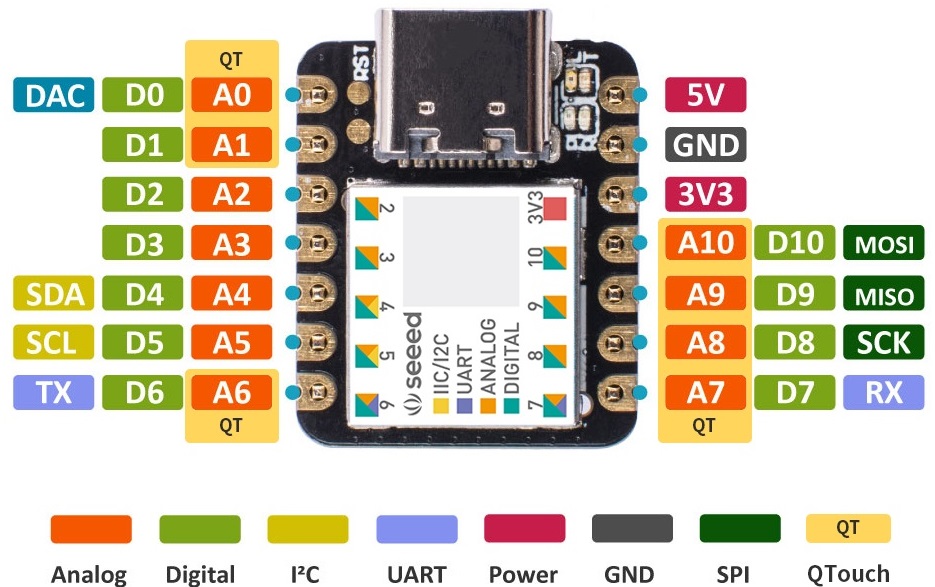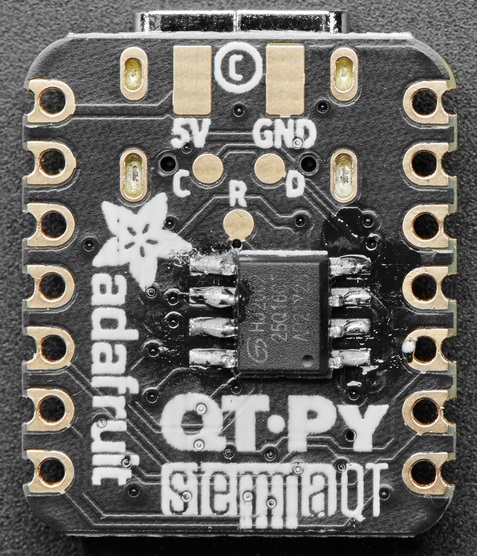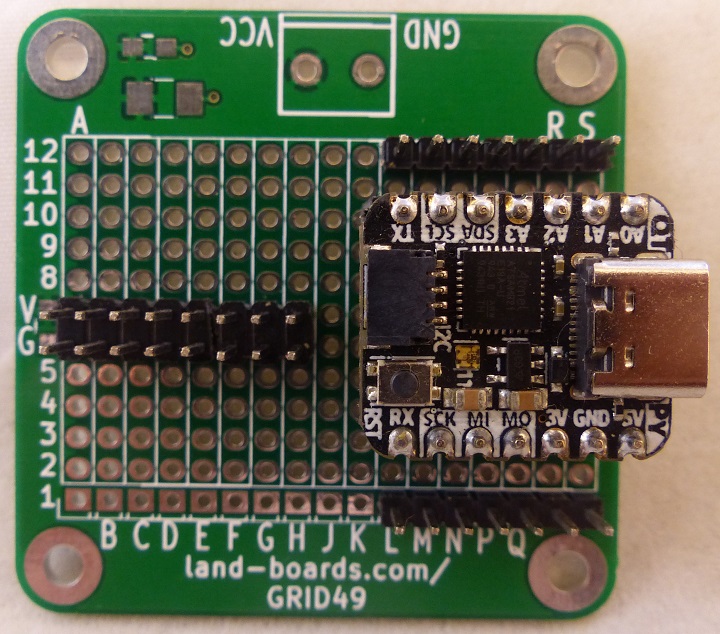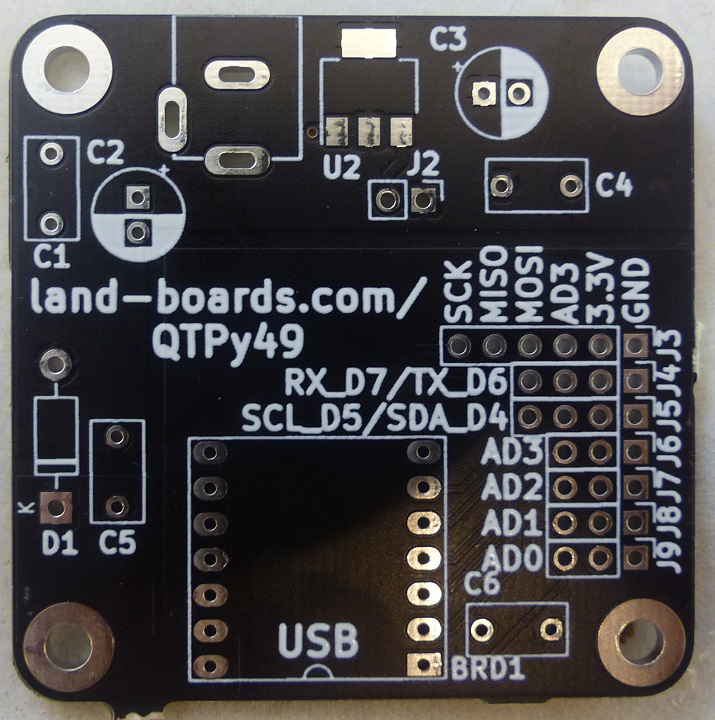QT Py (SAMD based)
Jump to navigation
Jump to search
Contents
- 1 Two Manufacturers (SAMD21)
- 2 Features
- 3 Pins
- 3.1 Adafruit SAMD Pinout
- 3.2 Seeed Studio SAMD Pinout
- 3.3 3V
- 3.4 5V
- 3.5 A0 / D0 - Digital/analog GPIO pin 0
- 3.6 A1 / D1 - Digital/analog GPIO pin 1
- 3.7 A2 / D2 - Digital/analog GPIO pin 2
- 3.8 A3 / D3 - Digital/analog GPIO pin 3
- 3.9 SDA / D4
- 3.10 SCL / D5
- 3.11 TX / A6 / D6
- 3.12 RX / A7 / D7
- 3.13 SCK / A8 / D8
- 3.14 MISO / A9 / D9
- 3.15 MOSI / A10 / D10
- 3.16 NeoPixel (Adafruit SAMD)
- 3.17 LED (XAIO)
- 4 Programming
- 5 Flash EEPROM 2 MB
- 6 QT Py Breakout Board
- 7 QTPy49 Board
- 8 Videos
Two Manufacturers (SAMD21)
Features
- ATSAMD21E18 32-bit Cortex M0+ version
- 48 MHz, 32-bit processor
- 256KB Flash
- 32 KB RAM
- Native USB supported by every OS
- Can be used in Arduino or CircuitPython as USB serial console, MIDI, Keyboard/Mouse HID, even a little disk drive for storing Python scripts.
- Built in RGB NeoPixel LED
- 11 GPIO pins:
- True analog output on one I/O pin
- Can be used to play 10-bit quality audio clips in Arduino
- CircuitPython does not have storage for audio clips
- Can be used to play 10-bit quality audio clips in Arduino
- 9 x 12-bit analog inputs (SDA/SCL do not have analog inputs)
- 1 x Optional AREF on A1
- 9 x PWM outputs (A0 is analog out, A1 is not PWM capable)
- Hardware I2C port with STEMMA QT plug-n-play connector
- Hardware UART
- Hardware SPI
- Hardware I2S
- 6 x Capacitive Touch with no additional components required
- True analog output on one I/O pin
- 3.3V regulator with AP2112, 600mA peak output
- Reset switch for starting your project code over or entering bootloader mode
- USB Type C connector
Optional External Flash (Adafruit QT Py Only)
- Optional 2 MB SOIC-8 SPI Flash chip on bottom
- Can't use castellated pins if Flash on bottom is installed
- GD25Q16
- Access the SPI flash in Arduino on SPI1 and chip select pin 17
- In CircuitPython, a 'haxpress' version of the runtime will need to be installed, so it knows to look for the larger filesystem
- There is more hardware support in the haxpress CircuitPython build because Adafruit added more code to the internal flash instead of using it for a filesystem
- Built-in modules available: adafruit_pixelbuf, analogio, audiobusio, audiocore, audioio, board, busio, digitalio, displayio, errno, fontio, math, microcontroller, neopixel_write, nvm, onewireio, os, paralleldisplay, pulseio, pwmio, rainbowio, random, rotaryio, rtc, storage, struct, supervisor, terminalio, time, touchio, traceback, usb_cdc, usb_hid, usb_midi
Pins
Adafruit SAMD Pinout
(Click on image for larger file)
Seeed Studio SAMD Pinout
3V
- Regulated output from the onboard regulator. You can draw 500mA
5V
- 5v out from the USB port.
- Voltage input
- Requires external diode
- Schottky, signal, power
- Between external power source and this pin
- Cannot power the USB port by supplying 5V to this pin
- There is a protection diode that prevents the 5V from reaching the USB connector.
- This is to protect host computer USB ports, etc.
- Requires external diode
A0 / D0 - Digital/analog GPIO pin 0
- Digital I/O 0
- Analog In 0
- True analog output with 10 bit precision
- Does not have PWM
- Capacitive touch input.
A1 / D1 - Digital/analog GPIO pin 1
- Digital I/O 1
- Analog In 1
- Capacitive touch input
- AREF pin.
A2 / D2 - Digital/analog GPIO pin 2
- Digital I/O 2
- Analog In 2
- PWM
- Capacitive touch input.
A3 / D3 - Digital/analog GPIO pin 3
- Digital I/O 3
- Analog In 3
- PWM output
- Capacitive touch input.
SDA / D4
- Digital I/O 4
- I2C SDA pin
- PWM output
- No analog on this pin
- No pull up on this pin
- When using with I2C requires an external 2.2K-10K pullup to 3.3V.
SCL / D5
- Digital I/O 5
- I2C SCL
- No analog on this pin
- No pull up on this pin
- When using with I2C requires an external 2.2K-10K pullup to 3.3V.
TX / A6 / D6
- Digital I/O 6
- Transmit (output) for Serial1
- Analog 6
- PWM output
- Capacitive touch input
RX / A7 / D7
- Digital I/O 7
- Receive (input) for Serial1
- Analog 7
- PWM output
- Capacitive touch input
SCK / A8 / D8
- Digital I/O 8
- SPI SCK pin
- Analog 8
- PWM output
MISO / A9 / D9
- Digital I/O 8
- SPI MISO pin
- Analog 8
- PWM output
MOSI / A10 / D10
- Digital I/O 10
- SPI MOSI pin
- Analog 10
- PWM output
NeoPixel (Adafruit SAMD)
- The XAIO does not have a NeoPixel on-board
- The Adafruit QT Py SAMD board does not have an individual
- NeoPixel Blink sketch (Arduino)
- Neopixel sketch (Arduino)
- Connected to digital pin 11 for signal
- Set pin 12 low for low power usage
- By default pin 12 is set high by Arduino/CircuitPython
- Python code example
import board import neopixel pixels = neopixel.NeoPixel(board.NEOPIXEL, 1) # fill((rVal, gVal, bVal)) # rVal, gVal, bVal = red/green/blue values (0-255) pixels.fill((255, 0, 0)) # Note double parens
LED (XAIO)
- On-board LED
Programming
- The SAMD on the QT Py and XIAO cards can be programmed using
- C/C++
- CircuitPython
- MicroPython
C/C++
- Different Arduino installs for QT Py and XIAO
C/C++ QT Py
- Arduino QT Py IDE Setup
- Requires Arduino IDE version 1.8 or higher
- Add to Preferences Additional Boards Manager URLs
https://adafruit.github.io/arduino-board-index/package_adafruit_index.json
C/C++ Seeeduino XIAO
- Seeeduino XIAO Get Started By Nanase
- Arduino XIAO Setup
- Add to Preferences Additional Boards Manager URLs
https://files.seeedstudio.com/arduino/package_seeeduino_boards_index.json
- Tools-> Board-> Boards Manager..., search for "Seeeduino XIAO"
- Tools-> Board, find "Seeeduino XIAO M0"
- Select the serial device of the Arduino board from the Tools | Serial Port menu
CircuitPython
- CircuitPython is a derivative of MicroPython
- CircuitPython looks for a code file on the board to run
- There are four options: code.txt, code.py, main.txt and main.py
- CircuitPython looks for those files, in that order, and then runs the first one it finds
- Mu code editor
- Thonny Python Development Environment
Adafruit CircuitPython
- Adafruit QT Py CircuitPython page
- Adafruit Learning System for QT Py
- Adafruit CircuitPython 7.3.0 on 2021-01-21
- QT Py CircuitPython Download
- QT Py Haxpress used with 2MB Flash EEPROM
- QT_Py_blink.py
- Free memory
- Reports 17,776 bytes of free space
import gc gc.mem_free()
Updating CircuitPython
- Save the contents of CIRCUITPY, just in case
- Double-click the reset button to show the BOOT drive
- Drag the update-bootloader.uf2 file to the BOOT drive
- Wait a few tens of seconds for the bootloader to update; the BOOT drive will reappear
- Check INFO_UF2.TXT to verify that the bootloader version has been updated. Then you will need to reload CircuitPython.
- Update mpy files
SeeedStudio CircuitPython for SAMD
Land Boards CircuitPython Code
I2CIO-8 (MCP23008) Drivers
- GitHub Repo
- I2CIO8.py Demo code - Bounce an LED across MCP23008 card output pins
- I2CIO8_RW.py - Read jumpers, write back LEDs
SWLEDX8-I2C (MCP23017) Drivers
- SWLEDX8.py = Control the SWLEDX8-I2C card
PROTO16-I2C (MCP23017) Drivers
- PROTO16_Blink.py - Control the PROTO16-I2C card
Digital I/O Example
import board
import digitalio
import time
led = digitalio.DigitalInOut(board.D13)
led.direction = digitalio.Direction.OUTPUT
while True:
led.value = True
time.sleep(0.1)
led.value = False
time.sleep(0.5)
Flash EEPROM 2 MB
QT Py Breakout Board
- Built onto GRID49 card
- Socket for QT Py
- QT Py pins brought to header strips
- 3.3V power distribution on 2x8 header
Pins (CCW direction)
- S12 = A0
- R12 = A1
- Q12 = A2
- P12 = A3
- N12 = SDA
- M12 = SCL
- L12 = TX
- L1 = RX
- M1 = SCK
- N1 = MI
- P1 = MO
- Q1 = 3.3V
- R1 = GND
- S1 = 5V
- A6=B6=C6=D6=E6=F6=G6=H6 = GND
- A7=B7=C7=D7=E7=F7=G7=H7 = 3.3V
QTPy49 Board
Videos

